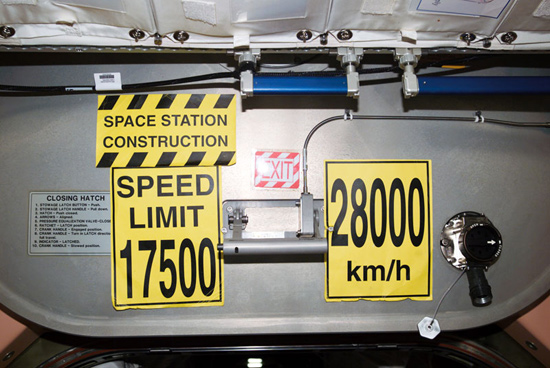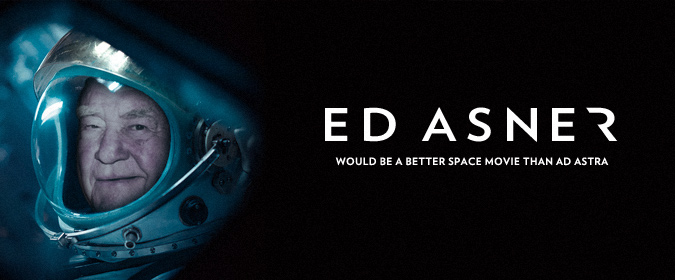I’ll start with this: As a film that (per its director) aspires to be “the most realistic depiction of space travel that’s been put in a movie,” Ad Astra blows chunks.
Let me tell you why, if you care.
SPOILER & SWEAR WARNING – DON’T READ PAST HERE IF EITHER WOULD RUIN YOUR DAY
Ad Astra is a film about fathers and sons, and one man’s search to find peace and meaning in his life. But you wouldn’t know that for most of its 124 minute running time.
At the start of the film, there’s a massive EMP (electromagnetic pulse) from space that shorts out electrical systems all over the Earth. As a result, Brad Pitt’s character falls off the “International Space Antenna” (it’s like a 60-mile high tower) which we’re told is being used by humanity to listen for aliens. The rationale is apparently that you need a really tall antenna—one that reaches all the way into space—to better listen for aliens. But (nerd alert) that’s not how radio works. Just getting above the atmosphere doesn’t help you listen for directional radio signals from space—you need a big dish antenna for that and ideally one you can point, not a whip/monopole antenna. If having your antenna in space is the trick, why not just build the thing in space? Better yet, on the far side of the Moon, where the Moon itself blocks out radio interference from Earth? (There is such a base in this film, but we’ll come back to it.) Can you ever under any circumstances imagine humanity spending what is surely trillions of dollars to build a giant space tower just to listen for aliens?
So soon enough, we learn that the EMP is being caused by an anti-matter experiment gone wrong near Neptune and that Brad Pitt’s dad—played by Tommy Lee Jones, whose expedition to search for aliens was lost 29 years ago—may be responsible. But why would you need to experiment with anti-matter to search for aliens? And if you actually had anti-matter 29 years ago, why send humans to Neptune to search for aliens when you could just build a fleet of anti-matter powered robotic space probes and send them out to the nearest stars to search? For that matter, how the hell could anything to do with anti-matter near Neptune cause EMPs back on Earth that threaten all life on the planet?
We’re also told that Pitt’s dad’s mission—Project Lima—was sent out to Neptune in order to get past the solar system’s heliopause boundary so as to better search for aliens. But the heliosphere extends way beyond the orbit of Neptune. And why the hell would getting past the heliopause help you to better search for aliens? Radio doesn’t work that way. We can hear Voyager 1’s radio signals just fine from Earth today—it’s past the heliopause boundary and its 22-watt radio is about as powerful as a refrigerator light bulb. But fuck—never mind.
Anyway, so the U.S. Space Command wants to send Brad Pitt’s character to Mars—the farthest manned U.S. outpost in the solar system—so he can communicate with his dad, who may still be alive, and get him to stop whatever the fuck he’s doing that’s threatening life on Earth. But why does Pitt’s character have to go to Mars to communicate with Neptune? Ahem... “International Space Antenna” anyone? You’ve got the biggest radio antenna in the solar system right there on Earth. Can’t you use that? Going to Mars doesn’t help you to communicate with Neptune better. Again, radio doesn’t work like that. Why even have the biggest radio antenna if you don’t use it for stuff like this? (The answer seems to be because the director wanted a scene where Pitt falls off a tower.)
Oh, but we’re told that Pitt’s meant to use a “secure laser” to send a message to his dad from Mars to Neptune, presumably so the conversation can’t be intercepted. But the whole idea of using a laser is that, unlike radio, it’s focused—it has a tight beam. It can’t be intercepted unless you’re in the narrow path of the beam. So if you have direct laser communications, you don’t need to go to Mars at all. You can just point your laser at Neptune from Earth. (But then of course there would be no point to the whole film.) Ah, fuck it. Moving on.
So Pitt has to go to Mars. Why can’t he just launch to Mars from Earth? Why does he have to fly commercial to the Moon first? (The answer seems to be that the director really wanted a scene where Pitt asks for a space blanket and the Virgin Atlantic stewardess—the director doesn’t bother to name the company Virgin Galactic, which is their actual spaceflight operation—charges him a $150 for it.) Why can’t Pitt launch into Earth orbit and link up with the Mars ship there? (The answer seems to be that the director really wanted a Moon buggy chase in his film. More on that in a minute). But whatever.
So Pitt goes to the Moon and arrives on Tycho Base. Which has neon signs for Yoshinoya, Applebee’s, and other restaurants on the outside where nobody actually goes for some goddamn silly reason. But anyway, so Pitt finally gets to the moonbase and now he can launch to Mars right? Nope. Because the launch pad for Mars is at another base on the far side of the Moon. So now Pitt’s got to take a moon buggy ride to the far side of the Moon to get to his Mars rocket. I shouldn’t have to tell any of you that launching from the far side of the Moon makes little goddamn difference in going to Mars vs. launching from the Yoshinoya beef bowl base, but again... Moon buggies.
So Pitt takes his Moon buggy ride, a la the old Rat Patrol TV show. And we learn there are pirates on the Moon now. (’Cause resources!) Of course, there are pirate Moon buggies just lying in wait for Pitt and company, so a Mad Max-style Moon buggy chase begins complete with zap guns and causalities. And Pitt finally arrives at the far side base by the skin of his teeth. But permit me a question or two.
Why the fuck are there pirates on the Moon again? Are they Russians? Chinese? Somali? Pittsburgh? If they’re after resources, resources are everywhere on the Moon. There’s more than enough to go around. And how fucking bad must the U.S. Space Command be if they can’t stop a fleet of pirate Moon buggies from picking off their soldiers? This isn’t Fallujah, for God’s sake. Where the hell are the pirates coming from? A secret pirate base? Then deal with it! At the end of the chase, we see the pirates being taken out by friendly missiles from orbit or somesuch. Hey, I’ve got an idea: Why not track the pirates back to their secret base and take the whole thing out with a missile? End of problem. Oh, but it’s a hidden base you say! To which I reply: Yeah, but there’s no fucking air on the Moon. Which means all you have to do is track the pirate rovers’ tire tracks back to their base to find it. You could do this from orbit. Hell, the kids from Scooby-Doo could do it.
But whatever.
Anyway, so Pitt gets to his Mars rocket, the Cepheus, and they finally launch for the red planet. At which point the crew starts taking drugs. Mood stabilizers, so called, because that’s apparently what James Gray figures all astronauts will have to do in space to deal with the stress of space travel (in spite of the fact that the Mars trip is only expected to take 17 days). And yet rather than stabilizing their moods, these pills seem to get all the astronauts high. ’Cause that’s just what you want on a space mission, right?
Moving on... so Pitt and company are on the way to Mars, when suddenly they get a distress call from a Norwegian biomedical research space station that’s apparently in orbit of a comet or asteroid (I forget which). Now... why would you put a station like this way out in orbit of a comet (or an asteroid) again? Why not just put it in a remote location on the Moon, or in Earth orbit? And why the fuck would you bring adult-sized baboons, which are nasty little fuckers, on that mission? They’re hard enough to deal with in a gravity field, much less in microgravity. And by the way, baboons have a maddening tendency to throw their own shit around, which is probably not conducive to good space hygiene. Anyway, the Norwegian biomedical researchers deserved their fucking fate in this film for being so goddamn stupid.
Pitt and the Cepheus crew finally do get to Mars, minus their commander (who was a moron), and just barely (thanks to their second-in-command, who is also a moron and a coward to boot—maybe it was all the drugs?) and now Pitt can finally communicate with his dad. So... why does the Mars base have an anechoic sound chamber for this purpose? Such chambers are used for acoustical testing, not for making phone calls or sending messages. (The answer seems to be because the director thought it looked cool... and of course the walls are red ’cause Mars and all.) Didn’t they have an anechoic sound chamber on the “International Space Antenna” back on Earth? Ah, fuck it.
So anyway, by this time Pitt is growing suspicious and he learns that the Cepheus is now going to be sent out to Neptune armed with nukes to kill his dad. (Making U.S. Space Command officially the dumbest organization in human history, because these drugged out morons are the last people you should ever give nukes to.) But Pitt is now deemed unstable by his superiors, so he’s being forced to stay in a happy room until he calms down. Naturally, he escapes and (with the help of someone on the base) gets his spacesuit and sneaks off to the launch pad to stow away aboard the Cepheus. But for some reason he has to do this by climbing down from the surface of Mars into an underground sewer pipe filled with water, through which he has to swim in his spacesuit. (’Cause as Star Trek Into Darkness has shown us, kids, if spaceships and spacesuits belong in space, they belong in water too!) And for some reason, there’s a rope line in said pipe that Pitt can conveniently use to pull himself perfectly along underwater to the very hatch he needs to reach in order to board the Cepheus. Which he does, just as the rocket launches. And because the Cepheus crew are morons, they essentially all kill themselves with their own ineptitude by the time the rocket actually reaches space, conveniently leaving only Pitt and the nukes aboard, ’cause plot and all.
And fuck it, I’m so goddamn done with this movie.
Pitt eventually reaches Neptune and finds his dad and it’s stupid but somehow we’re supposed to find it all deeply profound, ’cause Pitt sheds a space tear. Turns out his daddy just went far out space nuts because he didn’t find what he was looking for. And Pitt gets back to Earth by surfing a nuclear explosion. Ugh. I’ll spare you the details.
Except this one: On board the Lima Project spacecraft or station or whatever it is, there are a couple of signs. They’re identical to ones aboard the real International Space Station (pictured below). These are jokes for the crew, because the orbital speed of the ISS relative to an observer on the ground is roughly 17,500 mph (or 28,000 kph). I would bet you a $1000 right now that the reason those signs are aboard the Lima Project set in this movie is because the film’s production design team (who, based on the design of the spaceships in this film, are obviously Kerbal Space Program enthusiasts) saw them in NASA pictures of the ISS and figured they’d include them ’cause authenticity! Except the speed of any spacecraft that can reach the outer solar system (where Neptune and the heliopause are) is vastly higher than this; 17,500 is only accurate for the ISS (or other craft orbiting the Earth), certainly not for Lima Project.

To sum: Ad Astra is one of the dumbest goddamn space movies I have ever seen.
It’s Armageddon dumb, Disney’s Mission to Mars dumb, Battlefield Earth dumb, Space Cowboys dumb, Prometheus dumb, The Happening dumb, almost Hot Tub Time Machine dumb. I know those last two aren’t technically space movies, but that’s how dumb this is.
Hell, Lost in Space makes more sense... and I’m talking about the original Irwin Allen show, not the new Netflix reboot. But that also makes far more sense than this film.
I will say this much in its favor: Pitt gives a nuanced and occasionally moving performance. There are two good set pieces, including the aforementioned fall through the atmosphere from the tower and the Moon buggy chase. And there are some nice visuals. But the technical accuracy is ludicrous, the world building is ramshackle, the film employs every trope and cliché in the book, and verisimilitude is low indeed.
Now, look… if you liked Ad Astra, I salute you. If you found its message to be profound… and Brad Pitt’s space tear to be moving… then rock on, more power to you. Far be it from me to tell anyone what they should enjoy or not. There are plenty of dumb movies that I love. But speaking personally, I tend to like at least a little plausible science in my “realistic” science fiction films. And there isn’t much of that here.
If you called this film Tom Corbett: Space Cadet with 1950s-style production design a la Forbidden Planet, I’d happily just go with it. (With sincere apologies to the Tom Corbett fans among you.) But for a film that aspires to be the most realistic space film ever... yeah, not so much. If this is what passes for profound realistic space movies these days, I weep for the genre.
By the way, my wife heard the title of this film and joked: “Ed Asner does not belong in space.”
She’s right, of course. But I can’t help thinking I’d actually enjoy an Ed Asner space movie a lot more than this.
It goes without saying, but Ad Astra is most assuredly not recommended. Not even 4K Ultra HD would make this film viewing experience one I’d care to repeat.
Stay tuned...
-Bill Hunt

(You can follow Bill on social media at these links: Twitter and Facebook)






